Strategic Management: Knowledge, Learning and Woolworths Analysis
VerifiedAdded on 2022/08/08
|14
|3644
|26
Essay
AI Summary
This essay examines strategic management principles, focusing on knowledge creation, organizational learning, and the application of these concepts to the Woolworths Group. It begins with an introduction to strategic management, emphasizing the importance of preparing for the future and achieving competitive advantages through cross-functional decision-making. The essay delves into Nonaka's knowledge creation theory, particularly the SECI model, and how it relates to Woolworths' strategic approach. The paper then provides a background on Woolworths, a major Australian retail company, and discusses the company's strategies for knowledge management, strategic development, strategic marketing, business sustainability, and managing strategic corporate change. It evaluates the use of strategic frameworks and tools, including knowledge audits and marketing strategies. The essay highlights the importance of aligning knowledge management strategies with overall business objectives and the role of technology in achieving competitive advantages. Furthermore, it explores the significance of co-creation of knowledge with customers and other stakeholders. The conclusion summarizes the key findings and emphasizes the critical role of knowledge management in achieving sustainable competitive advantage in the dynamic business environment.
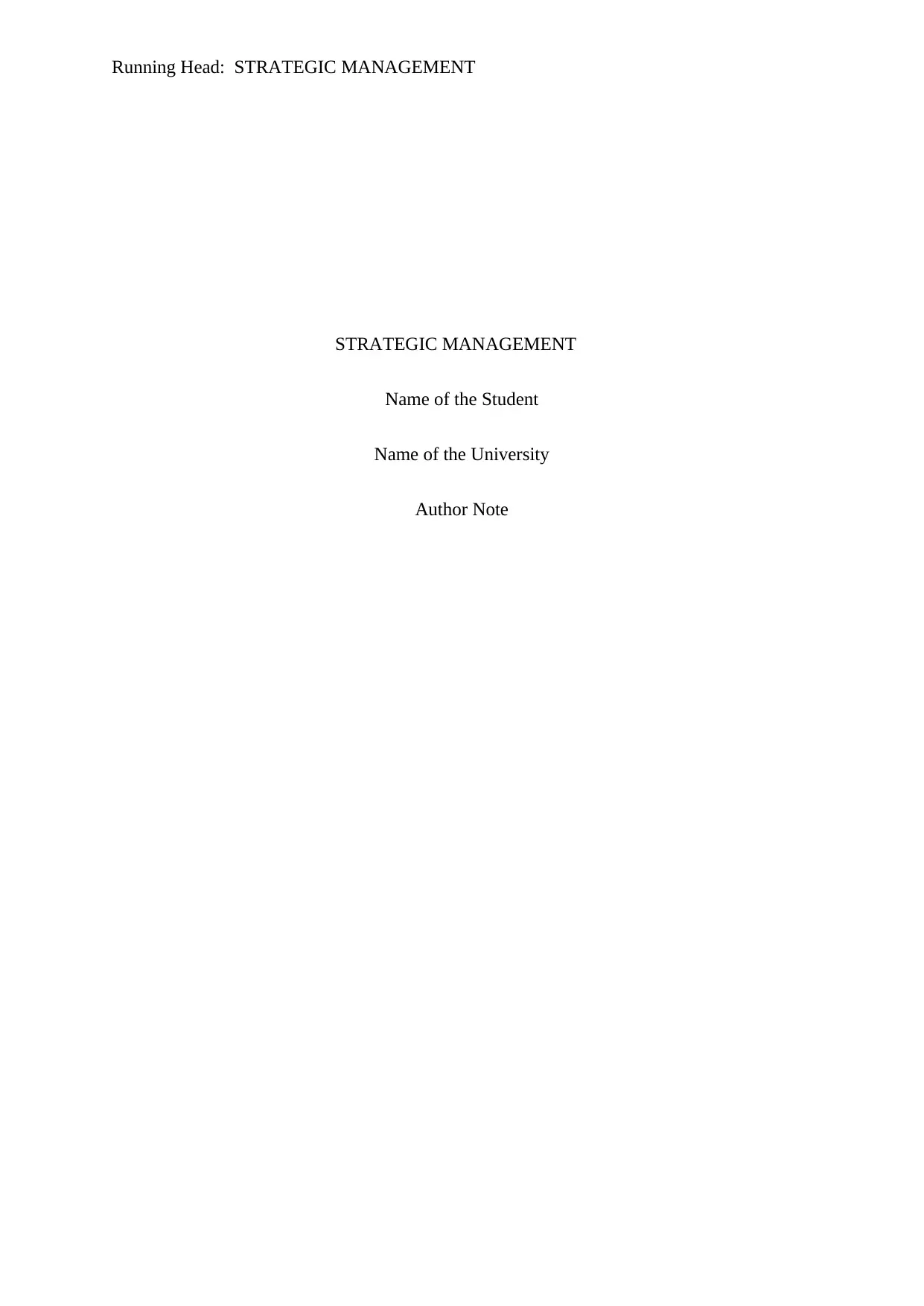
Running Head: STRATEGIC MANAGEMENT
STRATEGIC MANAGEMENT
Name of the Student
Name of the University
Author Note
STRATEGIC MANAGEMENT
Name of the Student
Name of the University
Author Note
Paraphrase This Document
Need a fresh take? Get an instant paraphrase of this document with our AI Paraphraser
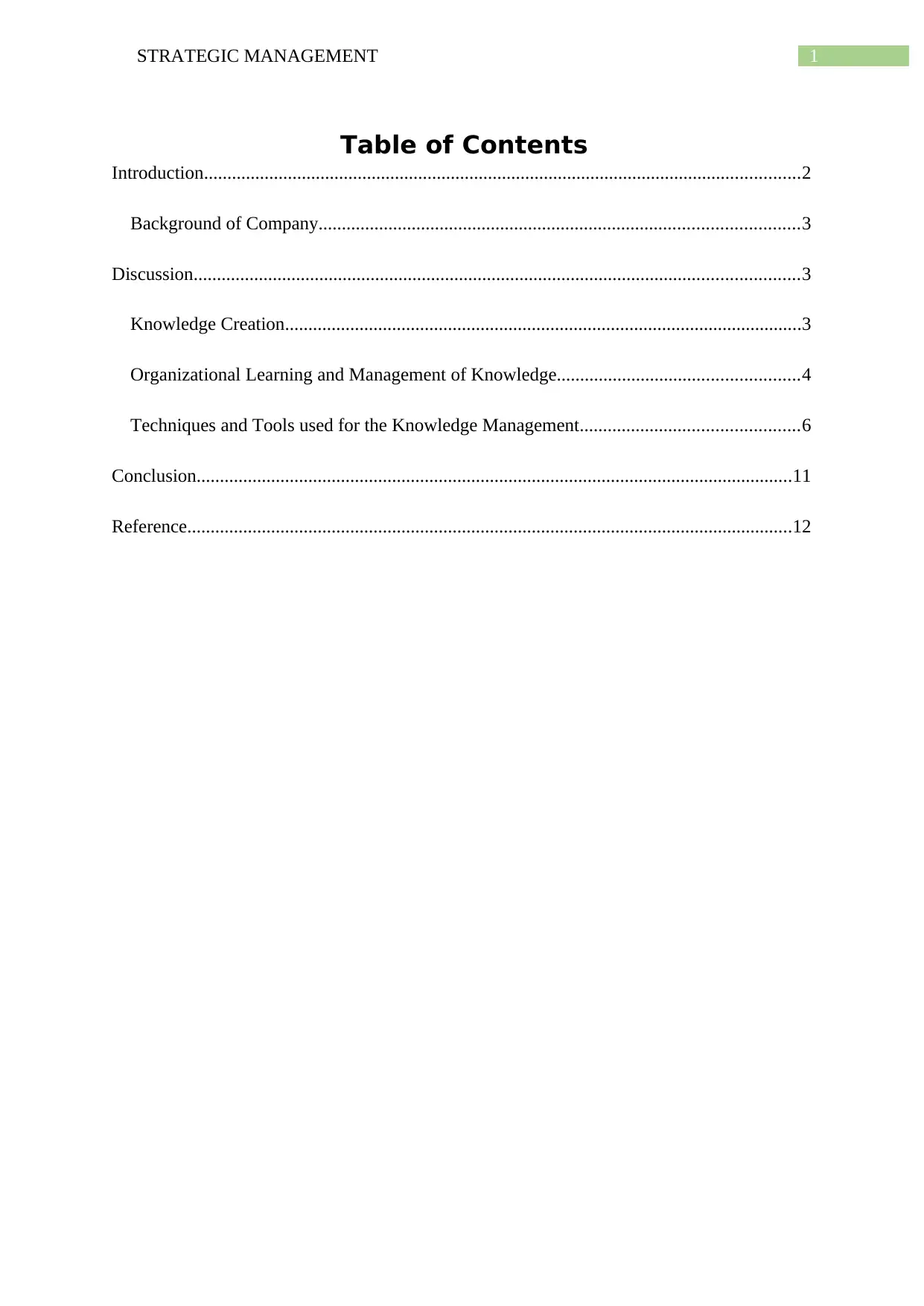
1STRATEGIC MANAGEMENT
Table of Contents
Introduction................................................................................................................................2
Background of Company.......................................................................................................3
Discussion..................................................................................................................................3
Knowledge Creation...............................................................................................................3
Organizational Learning and Management of Knowledge....................................................4
Techniques and Tools used for the Knowledge Management...............................................6
Conclusion................................................................................................................................11
Reference..................................................................................................................................12
Table of Contents
Introduction................................................................................................................................2
Background of Company.......................................................................................................3
Discussion..................................................................................................................................3
Knowledge Creation...............................................................................................................3
Organizational Learning and Management of Knowledge....................................................4
Techniques and Tools used for the Knowledge Management...............................................6
Conclusion................................................................................................................................11
Reference..................................................................................................................................12
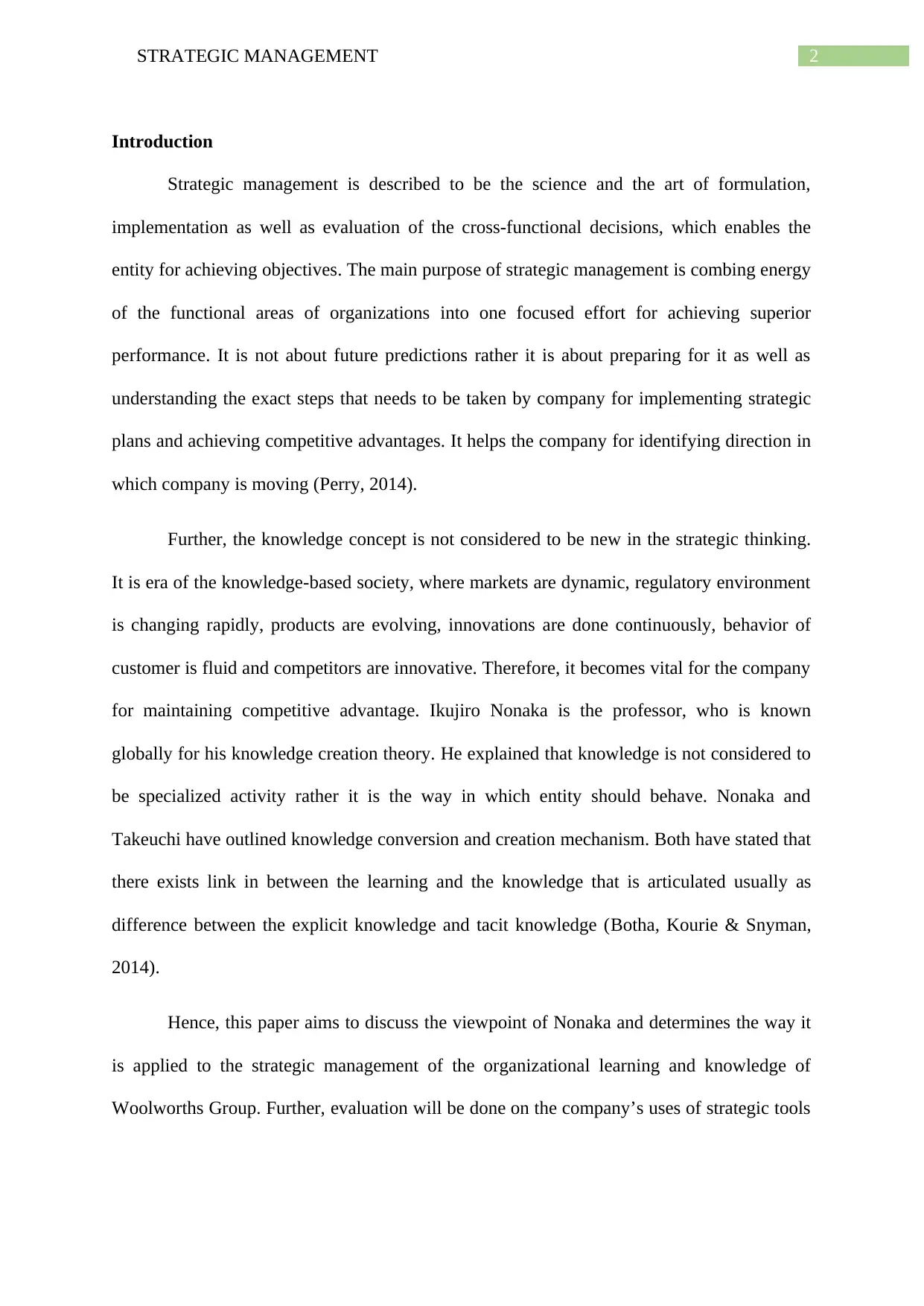
2STRATEGIC MANAGEMENT
Introduction
Strategic management is described to be the science and the art of formulation,
implementation as well as evaluation of the cross-functional decisions, which enables the
entity for achieving objectives. The main purpose of strategic management is combing energy
of the functional areas of organizations into one focused effort for achieving superior
performance. It is not about future predictions rather it is about preparing for it as well as
understanding the exact steps that needs to be taken by company for implementing strategic
plans and achieving competitive advantages. It helps the company for identifying direction in
which company is moving (Perry, 2014).
Further, the knowledge concept is not considered to be new in the strategic thinking.
It is era of the knowledge-based society, where markets are dynamic, regulatory environment
is changing rapidly, products are evolving, innovations are done continuously, behavior of
customer is fluid and competitors are innovative. Therefore, it becomes vital for the company
for maintaining competitive advantage. Ikujiro Nonaka is the professor, who is known
globally for his knowledge creation theory. He explained that knowledge is not considered to
be specialized activity rather it is the way in which entity should behave. Nonaka and
Takeuchi have outlined knowledge conversion and creation mechanism. Both have stated that
there exists link in between the learning and the knowledge that is articulated usually as
difference between the explicit knowledge and tacit knowledge (Botha, Kourie & Snyman,
2014).
Hence, this paper aims to discuss the viewpoint of Nonaka and determines the way it
is applied to the strategic management of the organizational learning and knowledge of
Woolworths Group. Further, evaluation will be done on the company’s uses of strategic tools
Introduction
Strategic management is described to be the science and the art of formulation,
implementation as well as evaluation of the cross-functional decisions, which enables the
entity for achieving objectives. The main purpose of strategic management is combing energy
of the functional areas of organizations into one focused effort for achieving superior
performance. It is not about future predictions rather it is about preparing for it as well as
understanding the exact steps that needs to be taken by company for implementing strategic
plans and achieving competitive advantages. It helps the company for identifying direction in
which company is moving (Perry, 2014).
Further, the knowledge concept is not considered to be new in the strategic thinking.
It is era of the knowledge-based society, where markets are dynamic, regulatory environment
is changing rapidly, products are evolving, innovations are done continuously, behavior of
customer is fluid and competitors are innovative. Therefore, it becomes vital for the company
for maintaining competitive advantage. Ikujiro Nonaka is the professor, who is known
globally for his knowledge creation theory. He explained that knowledge is not considered to
be specialized activity rather it is the way in which entity should behave. Nonaka and
Takeuchi have outlined knowledge conversion and creation mechanism. Both have stated that
there exists link in between the learning and the knowledge that is articulated usually as
difference between the explicit knowledge and tacit knowledge (Botha, Kourie & Snyman,
2014).
Hence, this paper aims to discuss the viewpoint of Nonaka and determines the way it
is applied to the strategic management of the organizational learning and knowledge of
Woolworths Group. Further, evaluation will be done on the company’s uses of strategic tools
⊘ This is a preview!⊘
Do you want full access?
Subscribe today to unlock all pages.

Trusted by 1+ million students worldwide
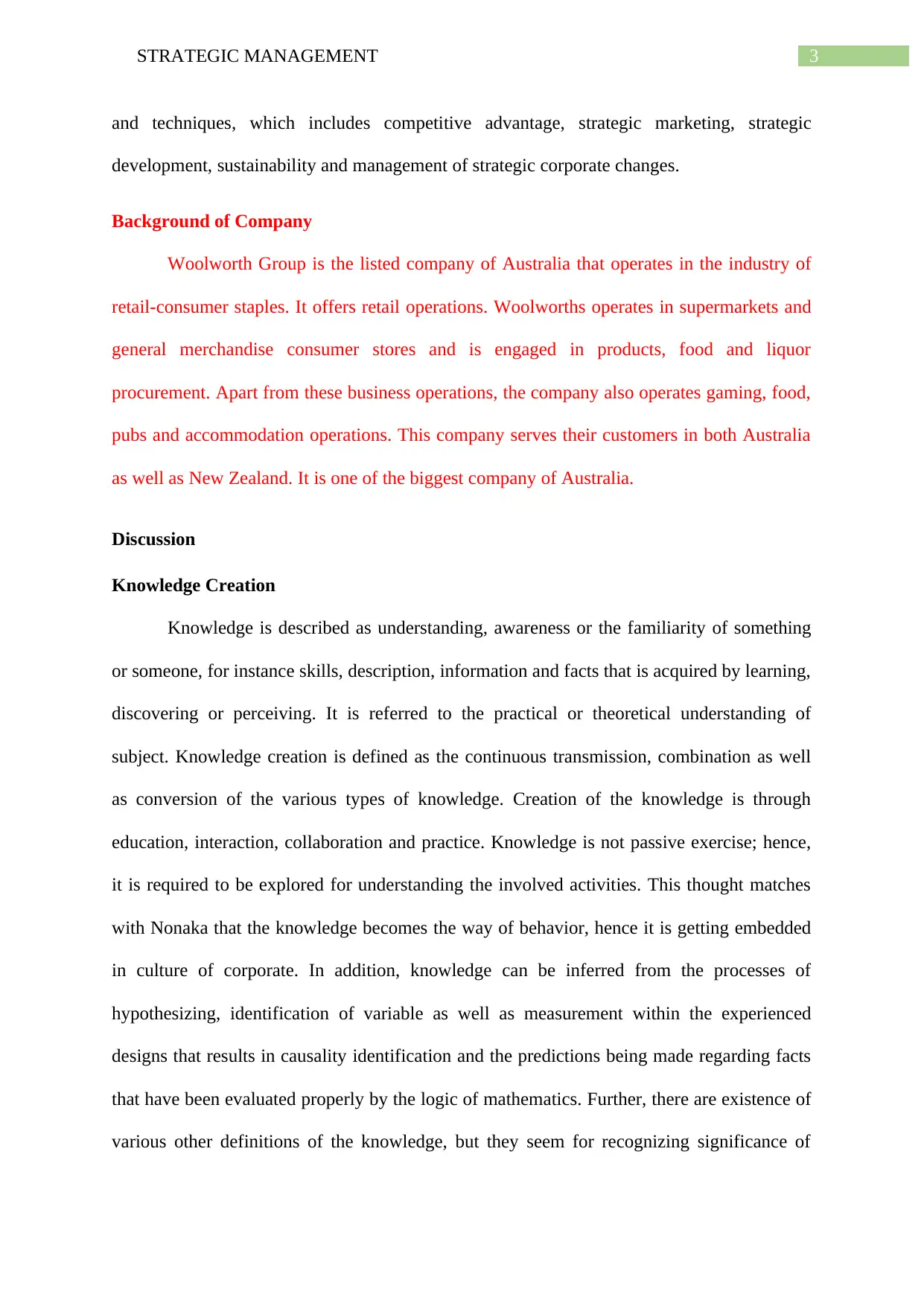
3STRATEGIC MANAGEMENT
and techniques, which includes competitive advantage, strategic marketing, strategic
development, sustainability and management of strategic corporate changes.
Background of Company
Woolworth Group is the listed company of Australia that operates in the industry of
retail-consumer staples. It offers retail operations. Woolworths operates in supermarkets and
general merchandise consumer stores and is engaged in products, food and liquor
procurement. Apart from these business operations, the company also operates gaming, food,
pubs and accommodation operations. This company serves their customers in both Australia
as well as New Zealand. It is one of the biggest company of Australia.
Discussion
Knowledge Creation
Knowledge is described as understanding, awareness or the familiarity of something
or someone, for instance skills, description, information and facts that is acquired by learning,
discovering or perceiving. It is referred to the practical or theoretical understanding of
subject. Knowledge creation is defined as the continuous transmission, combination as well
as conversion of the various types of knowledge. Creation of the knowledge is through
education, interaction, collaboration and practice. Knowledge is not passive exercise; hence,
it is required to be explored for understanding the involved activities. This thought matches
with Nonaka that the knowledge becomes the way of behavior, hence it is getting embedded
in culture of corporate. In addition, knowledge can be inferred from the processes of
hypothesizing, identification of variable as well as measurement within the experienced
designs that results in causality identification and the predictions being made regarding facts
that have been evaluated properly by the logic of mathematics. Further, there are existence of
various other definitions of the knowledge, but they seem for recognizing significance of
and techniques, which includes competitive advantage, strategic marketing, strategic
development, sustainability and management of strategic corporate changes.
Background of Company
Woolworth Group is the listed company of Australia that operates in the industry of
retail-consumer staples. It offers retail operations. Woolworths operates in supermarkets and
general merchandise consumer stores and is engaged in products, food and liquor
procurement. Apart from these business operations, the company also operates gaming, food,
pubs and accommodation operations. This company serves their customers in both Australia
as well as New Zealand. It is one of the biggest company of Australia.
Discussion
Knowledge Creation
Knowledge is described as understanding, awareness or the familiarity of something
or someone, for instance skills, description, information and facts that is acquired by learning,
discovering or perceiving. It is referred to the practical or theoretical understanding of
subject. Knowledge creation is defined as the continuous transmission, combination as well
as conversion of the various types of knowledge. Creation of the knowledge is through
education, interaction, collaboration and practice. Knowledge is not passive exercise; hence,
it is required to be explored for understanding the involved activities. This thought matches
with Nonaka that the knowledge becomes the way of behavior, hence it is getting embedded
in culture of corporate. In addition, knowledge can be inferred from the processes of
hypothesizing, identification of variable as well as measurement within the experienced
designs that results in causality identification and the predictions being made regarding facts
that have been evaluated properly by the logic of mathematics. Further, there are existence of
various other definitions of the knowledge, but they seem for recognizing significance of
Paraphrase This Document
Need a fresh take? Get an instant paraphrase of this document with our AI Paraphraser
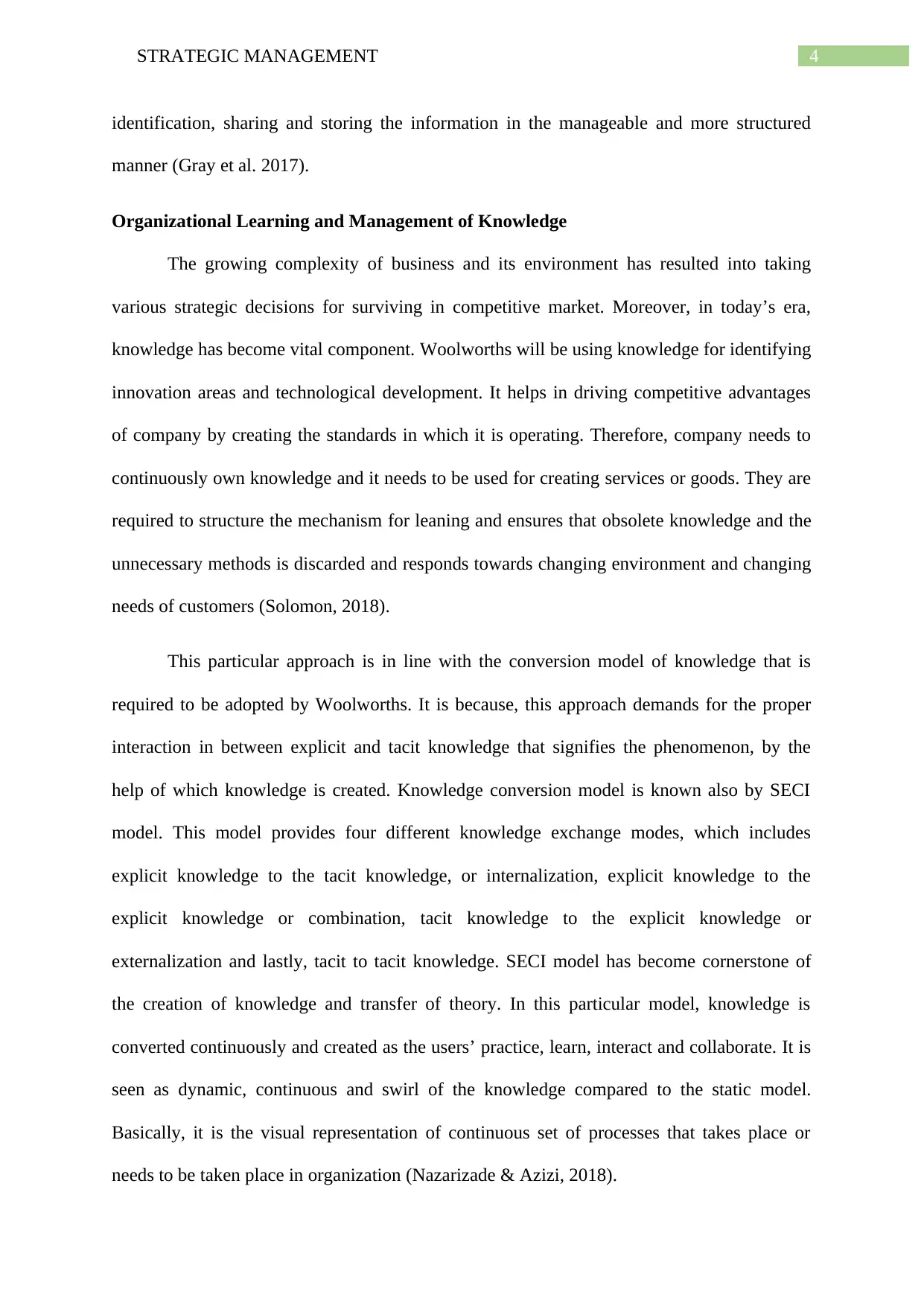
4STRATEGIC MANAGEMENT
identification, sharing and storing the information in the manageable and more structured
manner (Gray et al. 2017).
Organizational Learning and Management of Knowledge
The growing complexity of business and its environment has resulted into taking
various strategic decisions for surviving in competitive market. Moreover, in today’s era,
knowledge has become vital component. Woolworths will be using knowledge for identifying
innovation areas and technological development. It helps in driving competitive advantages
of company by creating the standards in which it is operating. Therefore, company needs to
continuously own knowledge and it needs to be used for creating services or goods. They are
required to structure the mechanism for leaning and ensures that obsolete knowledge and the
unnecessary methods is discarded and responds towards changing environment and changing
needs of customers (Solomon, 2018).
This particular approach is in line with the conversion model of knowledge that is
required to be adopted by Woolworths. It is because, this approach demands for the proper
interaction in between explicit and tacit knowledge that signifies the phenomenon, by the
help of which knowledge is created. Knowledge conversion model is known also by SECI
model. This model provides four different knowledge exchange modes, which includes
explicit knowledge to the tacit knowledge, or internalization, explicit knowledge to the
explicit knowledge or combination, tacit knowledge to the explicit knowledge or
externalization and lastly, tacit to tacit knowledge. SECI model has become cornerstone of
the creation of knowledge and transfer of theory. In this particular model, knowledge is
converted continuously and created as the users’ practice, learn, interact and collaborate. It is
seen as dynamic, continuous and swirl of the knowledge compared to the static model.
Basically, it is the visual representation of continuous set of processes that takes place or
needs to be taken place in organization (Nazarizade & Azizi, 2018).
identification, sharing and storing the information in the manageable and more structured
manner (Gray et al. 2017).
Organizational Learning and Management of Knowledge
The growing complexity of business and its environment has resulted into taking
various strategic decisions for surviving in competitive market. Moreover, in today’s era,
knowledge has become vital component. Woolworths will be using knowledge for identifying
innovation areas and technological development. It helps in driving competitive advantages
of company by creating the standards in which it is operating. Therefore, company needs to
continuously own knowledge and it needs to be used for creating services or goods. They are
required to structure the mechanism for leaning and ensures that obsolete knowledge and the
unnecessary methods is discarded and responds towards changing environment and changing
needs of customers (Solomon, 2018).
This particular approach is in line with the conversion model of knowledge that is
required to be adopted by Woolworths. It is because, this approach demands for the proper
interaction in between explicit and tacit knowledge that signifies the phenomenon, by the
help of which knowledge is created. Knowledge conversion model is known also by SECI
model. This model provides four different knowledge exchange modes, which includes
explicit knowledge to the tacit knowledge, or internalization, explicit knowledge to the
explicit knowledge or combination, tacit knowledge to the explicit knowledge or
externalization and lastly, tacit to tacit knowledge. SECI model has become cornerstone of
the creation of knowledge and transfer of theory. In this particular model, knowledge is
converted continuously and created as the users’ practice, learn, interact and collaborate. It is
seen as dynamic, continuous and swirl of the knowledge compared to the static model.
Basically, it is the visual representation of continuous set of processes that takes place or
needs to be taken place in organization (Nazarizade & Azizi, 2018).
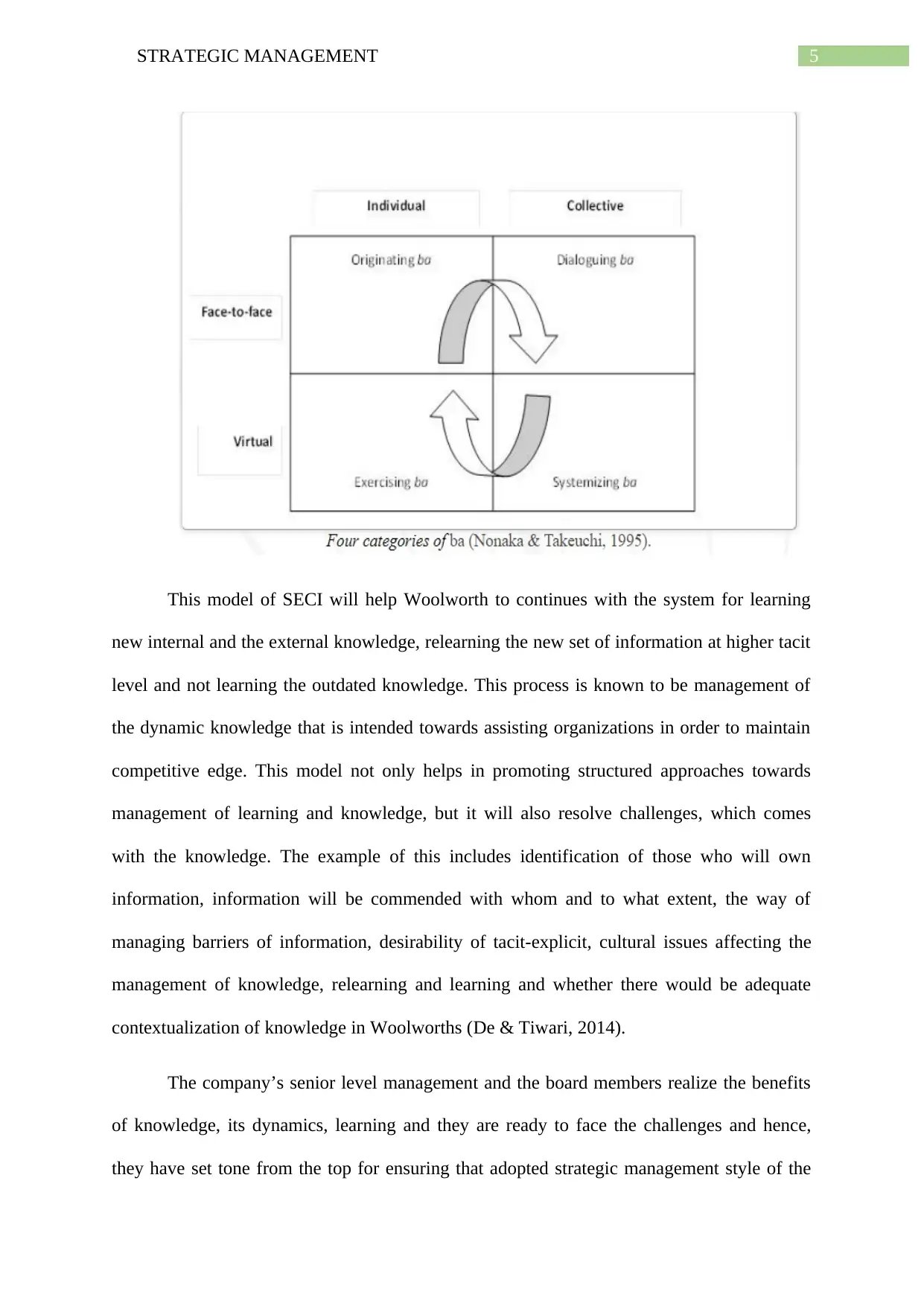
5STRATEGIC MANAGEMENT
This model of SECI will help Woolworth to continues with the system for learning
new internal and the external knowledge, relearning the new set of information at higher tacit
level and not learning the outdated knowledge. This process is known to be management of
the dynamic knowledge that is intended towards assisting organizations in order to maintain
competitive edge. This model not only helps in promoting structured approaches towards
management of learning and knowledge, but it will also resolve challenges, which comes
with the knowledge. The example of this includes identification of those who will own
information, information will be commended with whom and to what extent, the way of
managing barriers of information, desirability of tacit-explicit, cultural issues affecting the
management of knowledge, relearning and learning and whether there would be adequate
contextualization of knowledge in Woolworths (De & Tiwari, 2014).
The company’s senior level management and the board members realize the benefits
of knowledge, its dynamics, learning and they are ready to face the challenges and hence,
they have set tone from the top for ensuring that adopted strategic management style of the
This model of SECI will help Woolworth to continues with the system for learning
new internal and the external knowledge, relearning the new set of information at higher tacit
level and not learning the outdated knowledge. This process is known to be management of
the dynamic knowledge that is intended towards assisting organizations in order to maintain
competitive edge. This model not only helps in promoting structured approaches towards
management of learning and knowledge, but it will also resolve challenges, which comes
with the knowledge. The example of this includes identification of those who will own
information, information will be commended with whom and to what extent, the way of
managing barriers of information, desirability of tacit-explicit, cultural issues affecting the
management of knowledge, relearning and learning and whether there would be adequate
contextualization of knowledge in Woolworths (De & Tiwari, 2014).
The company’s senior level management and the board members realize the benefits
of knowledge, its dynamics, learning and they are ready to face the challenges and hence,
they have set tone from the top for ensuring that adopted strategic management style of the
⊘ This is a preview!⊘
Do you want full access?
Subscribe today to unlock all pages.

Trusted by 1+ million students worldwide
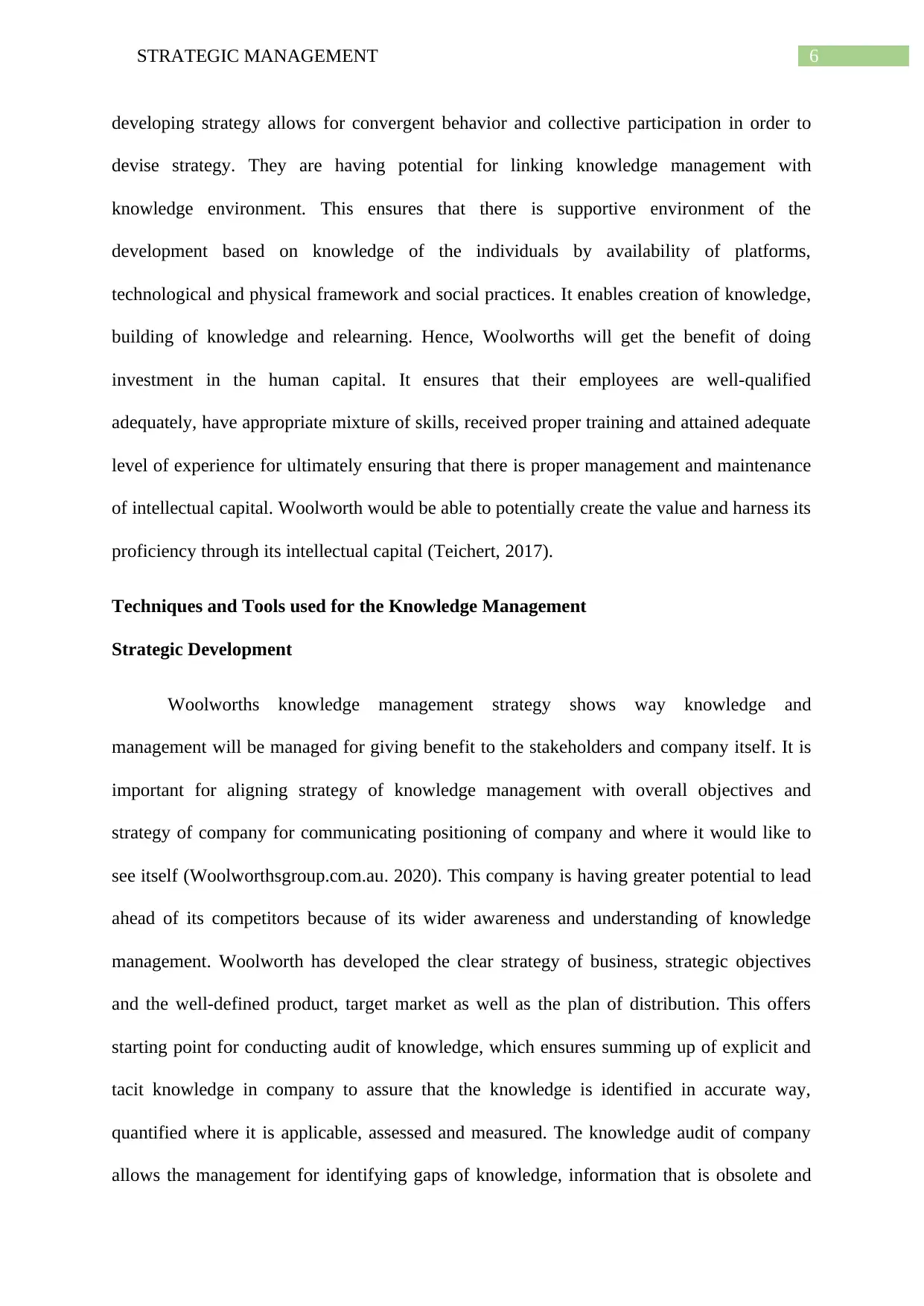
6STRATEGIC MANAGEMENT
developing strategy allows for convergent behavior and collective participation in order to
devise strategy. They are having potential for linking knowledge management with
knowledge environment. This ensures that there is supportive environment of the
development based on knowledge of the individuals by availability of platforms,
technological and physical framework and social practices. It enables creation of knowledge,
building of knowledge and relearning. Hence, Woolworths will get the benefit of doing
investment in the human capital. It ensures that their employees are well-qualified
adequately, have appropriate mixture of skills, received proper training and attained adequate
level of experience for ultimately ensuring that there is proper management and maintenance
of intellectual capital. Woolworth would be able to potentially create the value and harness its
proficiency through its intellectual capital (Teichert, 2017).
Techniques and Tools used for the Knowledge Management
Strategic Development
Woolworths knowledge management strategy shows way knowledge and
management will be managed for giving benefit to the stakeholders and company itself. It is
important for aligning strategy of knowledge management with overall objectives and
strategy of company for communicating positioning of company and where it would like to
see itself (Woolworthsgroup.com.au. 2020). This company is having greater potential to lead
ahead of its competitors because of its wider awareness and understanding of knowledge
management. Woolworth has developed the clear strategy of business, strategic objectives
and the well-defined product, target market as well as the plan of distribution. This offers
starting point for conducting audit of knowledge, which ensures summing up of explicit and
tacit knowledge in company to assure that the knowledge is identified in accurate way,
quantified where it is applicable, assessed and measured. The knowledge audit of company
allows the management for identifying gaps of knowledge, information that is obsolete and
developing strategy allows for convergent behavior and collective participation in order to
devise strategy. They are having potential for linking knowledge management with
knowledge environment. This ensures that there is supportive environment of the
development based on knowledge of the individuals by availability of platforms,
technological and physical framework and social practices. It enables creation of knowledge,
building of knowledge and relearning. Hence, Woolworths will get the benefit of doing
investment in the human capital. It ensures that their employees are well-qualified
adequately, have appropriate mixture of skills, received proper training and attained adequate
level of experience for ultimately ensuring that there is proper management and maintenance
of intellectual capital. Woolworth would be able to potentially create the value and harness its
proficiency through its intellectual capital (Teichert, 2017).
Techniques and Tools used for the Knowledge Management
Strategic Development
Woolworths knowledge management strategy shows way knowledge and
management will be managed for giving benefit to the stakeholders and company itself. It is
important for aligning strategy of knowledge management with overall objectives and
strategy of company for communicating positioning of company and where it would like to
see itself (Woolworthsgroup.com.au. 2020). This company is having greater potential to lead
ahead of its competitors because of its wider awareness and understanding of knowledge
management. Woolworth has developed the clear strategy of business, strategic objectives
and the well-defined product, target market as well as the plan of distribution. This offers
starting point for conducting audit of knowledge, which ensures summing up of explicit and
tacit knowledge in company to assure that the knowledge is identified in accurate way,
quantified where it is applicable, assessed and measured. The knowledge audit of company
allows the management for identifying gaps of knowledge, information that is obsolete and
Paraphrase This Document
Need a fresh take? Get an instant paraphrase of this document with our AI Paraphraser
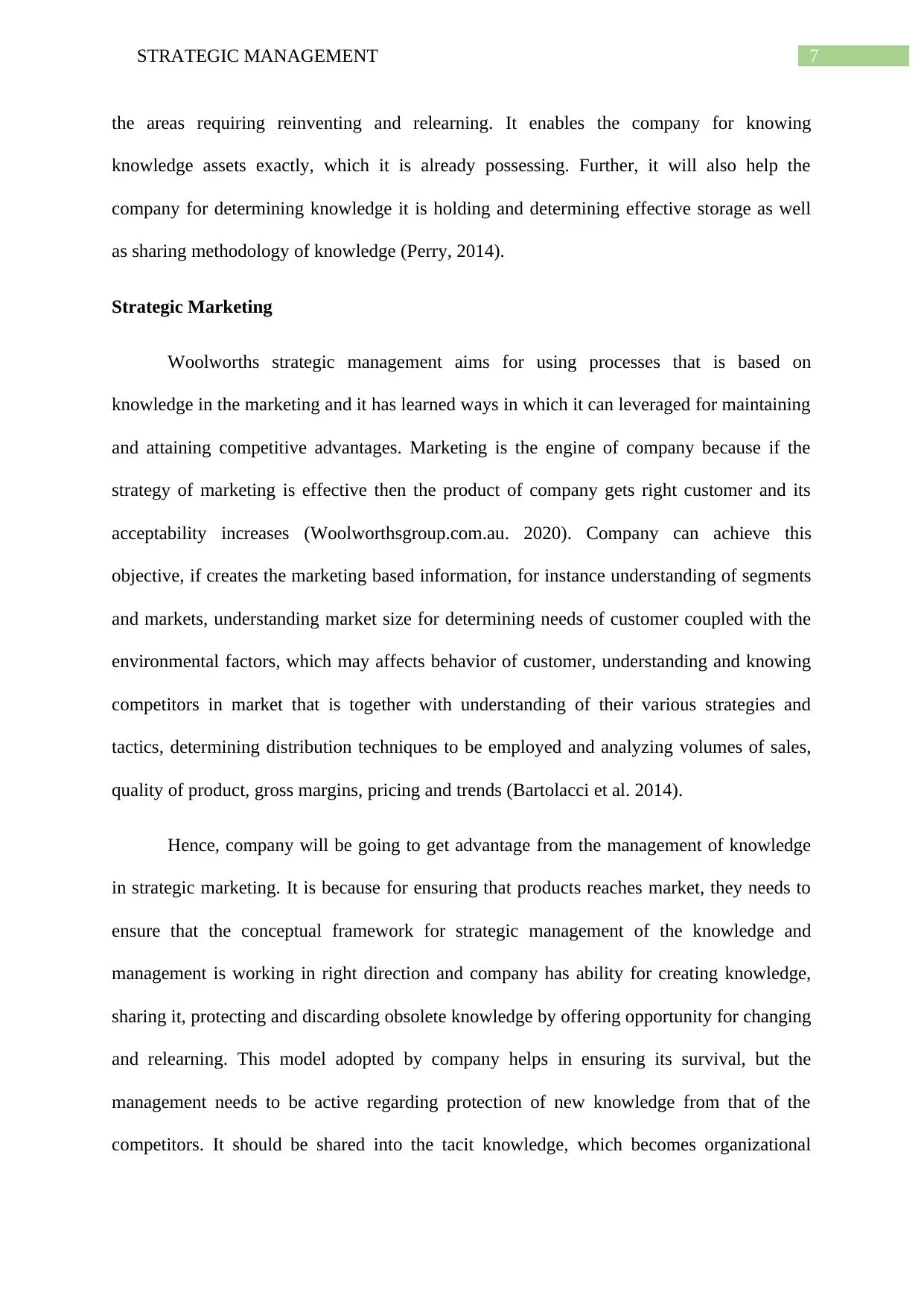
7STRATEGIC MANAGEMENT
the areas requiring reinventing and relearning. It enables the company for knowing
knowledge assets exactly, which it is already possessing. Further, it will also help the
company for determining knowledge it is holding and determining effective storage as well
as sharing methodology of knowledge (Perry, 2014).
Strategic Marketing
Woolworths strategic management aims for using processes that is based on
knowledge in the marketing and it has learned ways in which it can leveraged for maintaining
and attaining competitive advantages. Marketing is the engine of company because if the
strategy of marketing is effective then the product of company gets right customer and its
acceptability increases (Woolworthsgroup.com.au. 2020). Company can achieve this
objective, if creates the marketing based information, for instance understanding of segments
and markets, understanding market size for determining needs of customer coupled with the
environmental factors, which may affects behavior of customer, understanding and knowing
competitors in market that is together with understanding of their various strategies and
tactics, determining distribution techniques to be employed and analyzing volumes of sales,
quality of product, gross margins, pricing and trends (Bartolacci et al. 2014).
Hence, company will be going to get advantage from the management of knowledge
in strategic marketing. It is because for ensuring that products reaches market, they needs to
ensure that the conceptual framework for strategic management of the knowledge and
management is working in right direction and company has ability for creating knowledge,
sharing it, protecting and discarding obsolete knowledge by offering opportunity for changing
and relearning. This model adopted by company helps in ensuring its survival, but the
management needs to be active regarding protection of new knowledge from that of the
competitors. It should be shared into the tacit knowledge, which becomes organizational
the areas requiring reinventing and relearning. It enables the company for knowing
knowledge assets exactly, which it is already possessing. Further, it will also help the
company for determining knowledge it is holding and determining effective storage as well
as sharing methodology of knowledge (Perry, 2014).
Strategic Marketing
Woolworths strategic management aims for using processes that is based on
knowledge in the marketing and it has learned ways in which it can leveraged for maintaining
and attaining competitive advantages. Marketing is the engine of company because if the
strategy of marketing is effective then the product of company gets right customer and its
acceptability increases (Woolworthsgroup.com.au. 2020). Company can achieve this
objective, if creates the marketing based information, for instance understanding of segments
and markets, understanding market size for determining needs of customer coupled with the
environmental factors, which may affects behavior of customer, understanding and knowing
competitors in market that is together with understanding of their various strategies and
tactics, determining distribution techniques to be employed and analyzing volumes of sales,
quality of product, gross margins, pricing and trends (Bartolacci et al. 2014).
Hence, company will be going to get advantage from the management of knowledge
in strategic marketing. It is because for ensuring that products reaches market, they needs to
ensure that the conceptual framework for strategic management of the knowledge and
management is working in right direction and company has ability for creating knowledge,
sharing it, protecting and discarding obsolete knowledge by offering opportunity for changing
and relearning. This model adopted by company helps in ensuring its survival, but the
management needs to be active regarding protection of new knowledge from that of the
competitors. It should be shared into the tacit knowledge, which becomes organizational
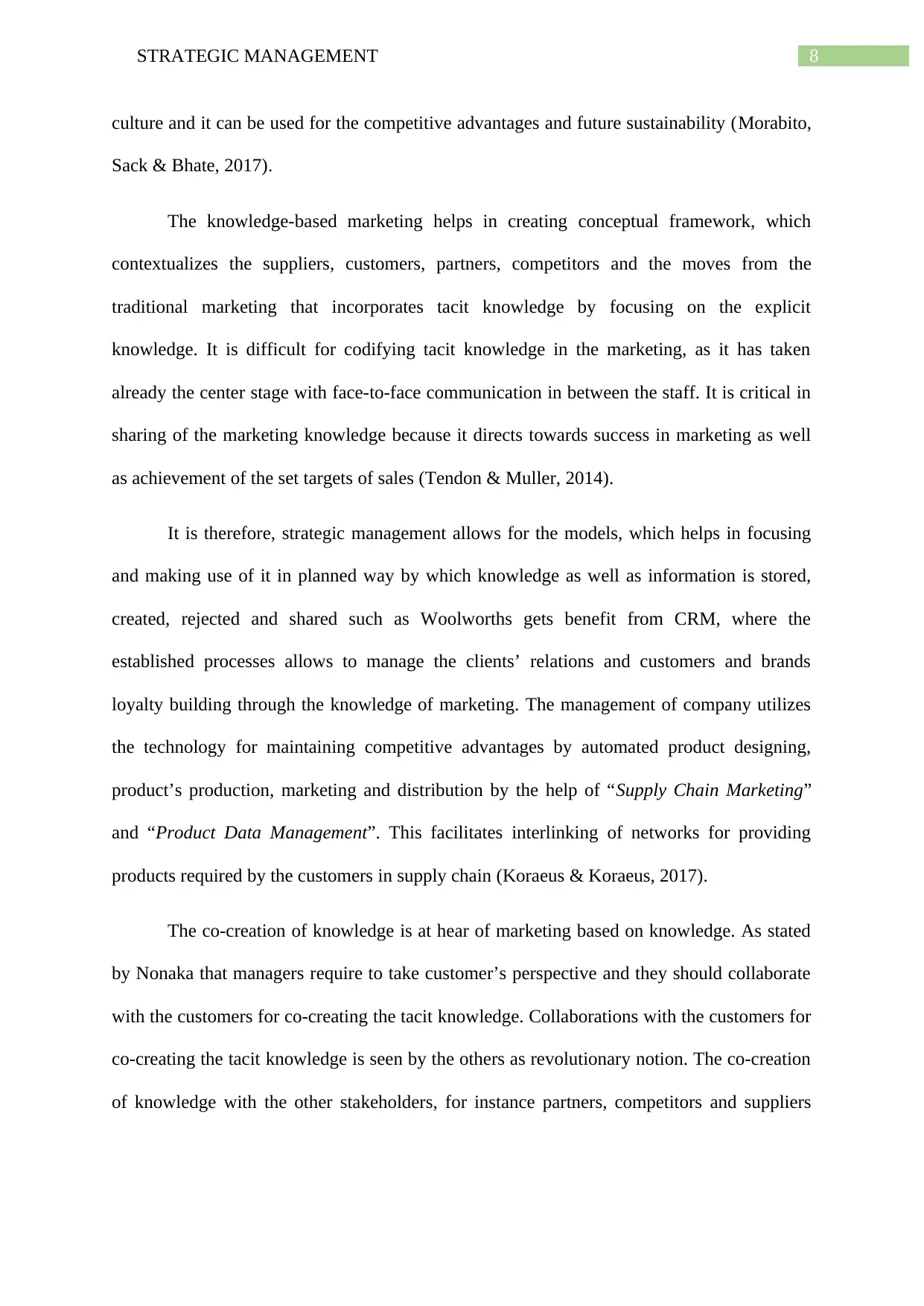
8STRATEGIC MANAGEMENT
culture and it can be used for the competitive advantages and future sustainability (Morabito,
Sack & Bhate, 2017).
The knowledge-based marketing helps in creating conceptual framework, which
contextualizes the suppliers, customers, partners, competitors and the moves from the
traditional marketing that incorporates tacit knowledge by focusing on the explicit
knowledge. It is difficult for codifying tacit knowledge in the marketing, as it has taken
already the center stage with face-to-face communication in between the staff. It is critical in
sharing of the marketing knowledge because it directs towards success in marketing as well
as achievement of the set targets of sales (Tendon & Muller, 2014).
It is therefore, strategic management allows for the models, which helps in focusing
and making use of it in planned way by which knowledge as well as information is stored,
created, rejected and shared such as Woolworths gets benefit from CRM, where the
established processes allows to manage the clients’ relations and customers and brands
loyalty building through the knowledge of marketing. The management of company utilizes
the technology for maintaining competitive advantages by automated product designing,
product’s production, marketing and distribution by the help of “Supply Chain Marketing”
and “Product Data Management”. This facilitates interlinking of networks for providing
products required by the customers in supply chain (Koraeus & Koraeus, 2017).
The co-creation of knowledge is at hear of marketing based on knowledge. As stated
by Nonaka that managers require to take customer’s perspective and they should collaborate
with the customers for co-creating the tacit knowledge. Collaborations with the customers for
co-creating the tacit knowledge is seen by the others as revolutionary notion. The co-creation
of knowledge with the other stakeholders, for instance partners, competitors and suppliers
culture and it can be used for the competitive advantages and future sustainability (Morabito,
Sack & Bhate, 2017).
The knowledge-based marketing helps in creating conceptual framework, which
contextualizes the suppliers, customers, partners, competitors and the moves from the
traditional marketing that incorporates tacit knowledge by focusing on the explicit
knowledge. It is difficult for codifying tacit knowledge in the marketing, as it has taken
already the center stage with face-to-face communication in between the staff. It is critical in
sharing of the marketing knowledge because it directs towards success in marketing as well
as achievement of the set targets of sales (Tendon & Muller, 2014).
It is therefore, strategic management allows for the models, which helps in focusing
and making use of it in planned way by which knowledge as well as information is stored,
created, rejected and shared such as Woolworths gets benefit from CRM, where the
established processes allows to manage the clients’ relations and customers and brands
loyalty building through the knowledge of marketing. The management of company utilizes
the technology for maintaining competitive advantages by automated product designing,
product’s production, marketing and distribution by the help of “Supply Chain Marketing”
and “Product Data Management”. This facilitates interlinking of networks for providing
products required by the customers in supply chain (Koraeus & Koraeus, 2017).
The co-creation of knowledge is at hear of marketing based on knowledge. As stated
by Nonaka that managers require to take customer’s perspective and they should collaborate
with the customers for co-creating the tacit knowledge. Collaborations with the customers for
co-creating the tacit knowledge is seen by the others as revolutionary notion. The co-creation
of knowledge with the other stakeholders, for instance partners, competitors and suppliers
⊘ This is a preview!⊘
Do you want full access?
Subscribe today to unlock all pages.

Trusted by 1+ million students worldwide
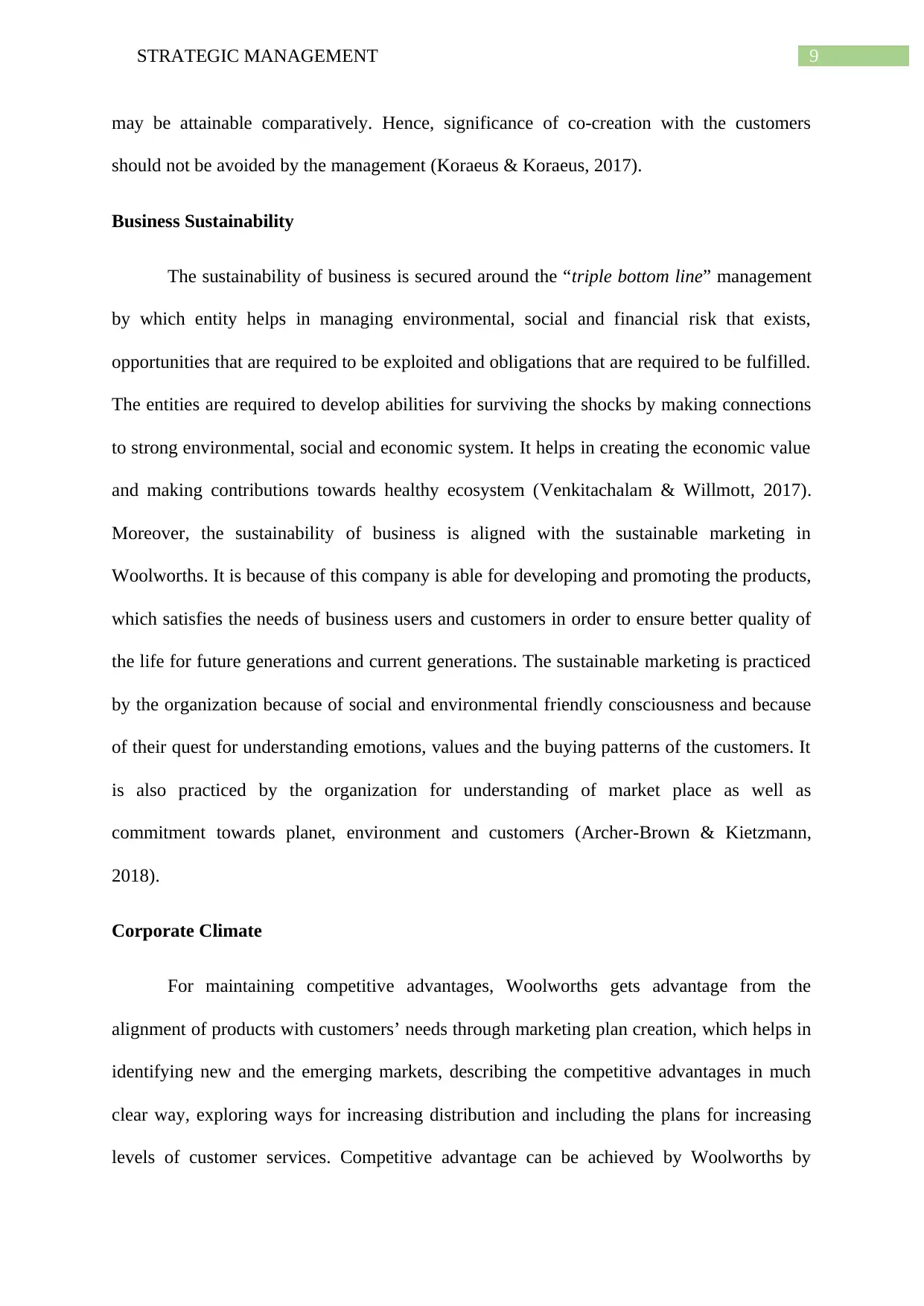
9STRATEGIC MANAGEMENT
may be attainable comparatively. Hence, significance of co-creation with the customers
should not be avoided by the management (Koraeus & Koraeus, 2017).
Business Sustainability
The sustainability of business is secured around the “triple bottom line” management
by which entity helps in managing environmental, social and financial risk that exists,
opportunities that are required to be exploited and obligations that are required to be fulfilled.
The entities are required to develop abilities for surviving the shocks by making connections
to strong environmental, social and economic system. It helps in creating the economic value
and making contributions towards healthy ecosystem (Venkitachalam & Willmott, 2017).
Moreover, the sustainability of business is aligned with the sustainable marketing in
Woolworths. It is because of this company is able for developing and promoting the products,
which satisfies the needs of business users and customers in order to ensure better quality of
the life for future generations and current generations. The sustainable marketing is practiced
by the organization because of social and environmental friendly consciousness and because
of their quest for understanding emotions, values and the buying patterns of the customers. It
is also practiced by the organization for understanding of market place as well as
commitment towards planet, environment and customers (Archer-Brown & Kietzmann,
2018).
Corporate Climate
For maintaining competitive advantages, Woolworths gets advantage from the
alignment of products with customers’ needs through marketing plan creation, which helps in
identifying new and the emerging markets, describing the competitive advantages in much
clear way, exploring ways for increasing distribution and including the plans for increasing
levels of customer services. Competitive advantage can be achieved by Woolworths by
may be attainable comparatively. Hence, significance of co-creation with the customers
should not be avoided by the management (Koraeus & Koraeus, 2017).
Business Sustainability
The sustainability of business is secured around the “triple bottom line” management
by which entity helps in managing environmental, social and financial risk that exists,
opportunities that are required to be exploited and obligations that are required to be fulfilled.
The entities are required to develop abilities for surviving the shocks by making connections
to strong environmental, social and economic system. It helps in creating the economic value
and making contributions towards healthy ecosystem (Venkitachalam & Willmott, 2017).
Moreover, the sustainability of business is aligned with the sustainable marketing in
Woolworths. It is because of this company is able for developing and promoting the products,
which satisfies the needs of business users and customers in order to ensure better quality of
the life for future generations and current generations. The sustainable marketing is practiced
by the organization because of social and environmental friendly consciousness and because
of their quest for understanding emotions, values and the buying patterns of the customers. It
is also practiced by the organization for understanding of market place as well as
commitment towards planet, environment and customers (Archer-Brown & Kietzmann,
2018).
Corporate Climate
For maintaining competitive advantages, Woolworths gets advantage from the
alignment of products with customers’ needs through marketing plan creation, which helps in
identifying new and the emerging markets, describing the competitive advantages in much
clear way, exploring ways for increasing distribution and including the plans for increasing
levels of customer services. Competitive advantage can be achieved by Woolworths by
Paraphrase This Document
Need a fresh take? Get an instant paraphrase of this document with our AI Paraphraser
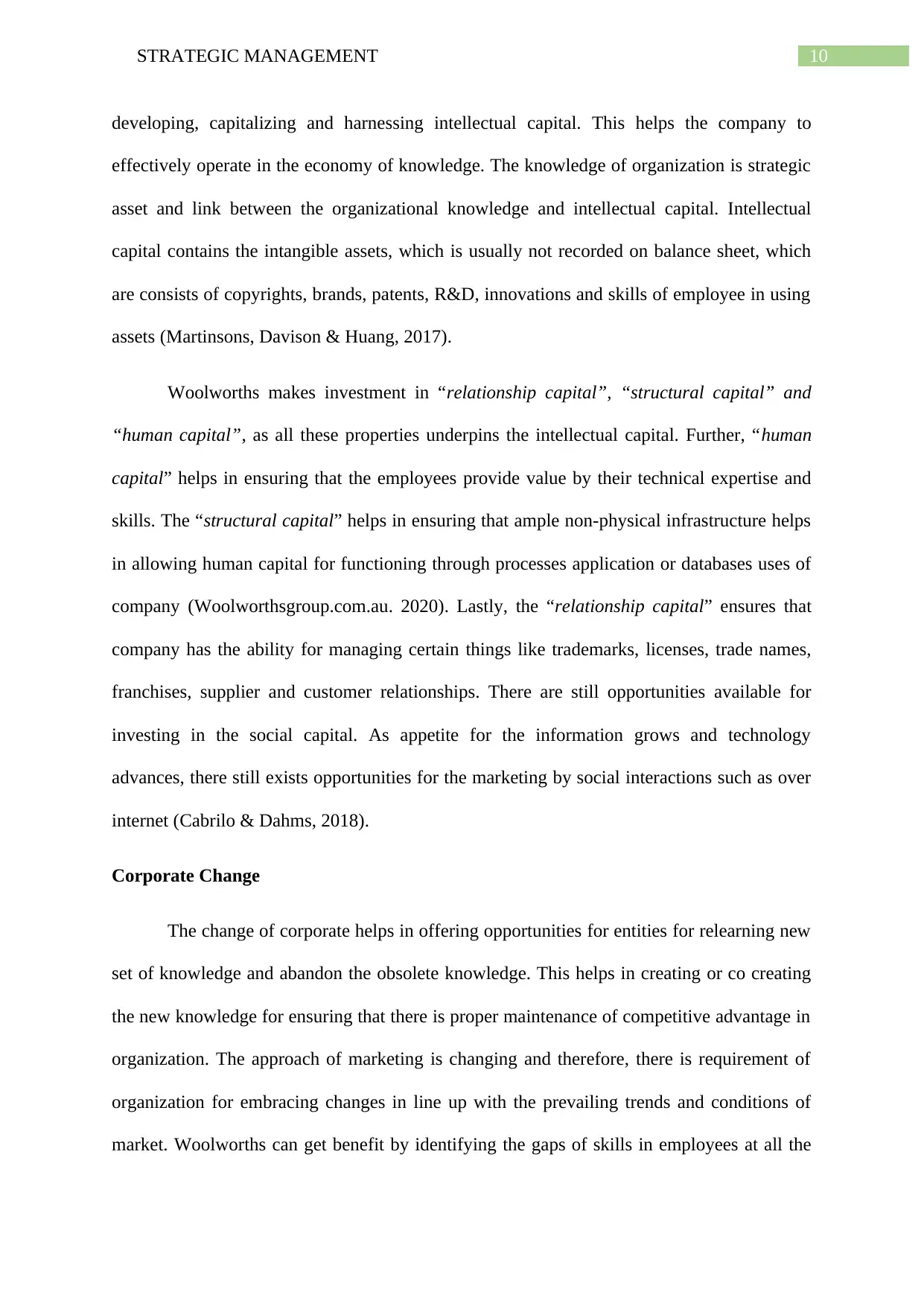
10STRATEGIC MANAGEMENT
developing, capitalizing and harnessing intellectual capital. This helps the company to
effectively operate in the economy of knowledge. The knowledge of organization is strategic
asset and link between the organizational knowledge and intellectual capital. Intellectual
capital contains the intangible assets, which is usually not recorded on balance sheet, which
are consists of copyrights, brands, patents, R&D, innovations and skills of employee in using
assets (Martinsons, Davison & Huang, 2017).
Woolworths makes investment in “relationship capital”, “structural capital” and
“human capital”, as all these properties underpins the intellectual capital. Further, “human
capital” helps in ensuring that the employees provide value by their technical expertise and
skills. The “structural capital” helps in ensuring that ample non-physical infrastructure helps
in allowing human capital for functioning through processes application or databases uses of
company (Woolworthsgroup.com.au. 2020). Lastly, the “relationship capital” ensures that
company has the ability for managing certain things like trademarks, licenses, trade names,
franchises, supplier and customer relationships. There are still opportunities available for
investing in the social capital. As appetite for the information grows and technology
advances, there still exists opportunities for the marketing by social interactions such as over
internet (Cabrilo & Dahms, 2018).
Corporate Change
The change of corporate helps in offering opportunities for entities for relearning new
set of knowledge and abandon the obsolete knowledge. This helps in creating or co creating
the new knowledge for ensuring that there is proper maintenance of competitive advantage in
organization. The approach of marketing is changing and therefore, there is requirement of
organization for embracing changes in line up with the prevailing trends and conditions of
market. Woolworths can get benefit by identifying the gaps of skills in employees at all the
developing, capitalizing and harnessing intellectual capital. This helps the company to
effectively operate in the economy of knowledge. The knowledge of organization is strategic
asset and link between the organizational knowledge and intellectual capital. Intellectual
capital contains the intangible assets, which is usually not recorded on balance sheet, which
are consists of copyrights, brands, patents, R&D, innovations and skills of employee in using
assets (Martinsons, Davison & Huang, 2017).
Woolworths makes investment in “relationship capital”, “structural capital” and
“human capital”, as all these properties underpins the intellectual capital. Further, “human
capital” helps in ensuring that the employees provide value by their technical expertise and
skills. The “structural capital” helps in ensuring that ample non-physical infrastructure helps
in allowing human capital for functioning through processes application or databases uses of
company (Woolworthsgroup.com.au. 2020). Lastly, the “relationship capital” ensures that
company has the ability for managing certain things like trademarks, licenses, trade names,
franchises, supplier and customer relationships. There are still opportunities available for
investing in the social capital. As appetite for the information grows and technology
advances, there still exists opportunities for the marketing by social interactions such as over
internet (Cabrilo & Dahms, 2018).
Corporate Change
The change of corporate helps in offering opportunities for entities for relearning new
set of knowledge and abandon the obsolete knowledge. This helps in creating or co creating
the new knowledge for ensuring that there is proper maintenance of competitive advantage in
organization. The approach of marketing is changing and therefore, there is requirement of
organization for embracing changes in line up with the prevailing trends and conditions of
market. Woolworths can get benefit by identifying the gaps of skills in employees at all the
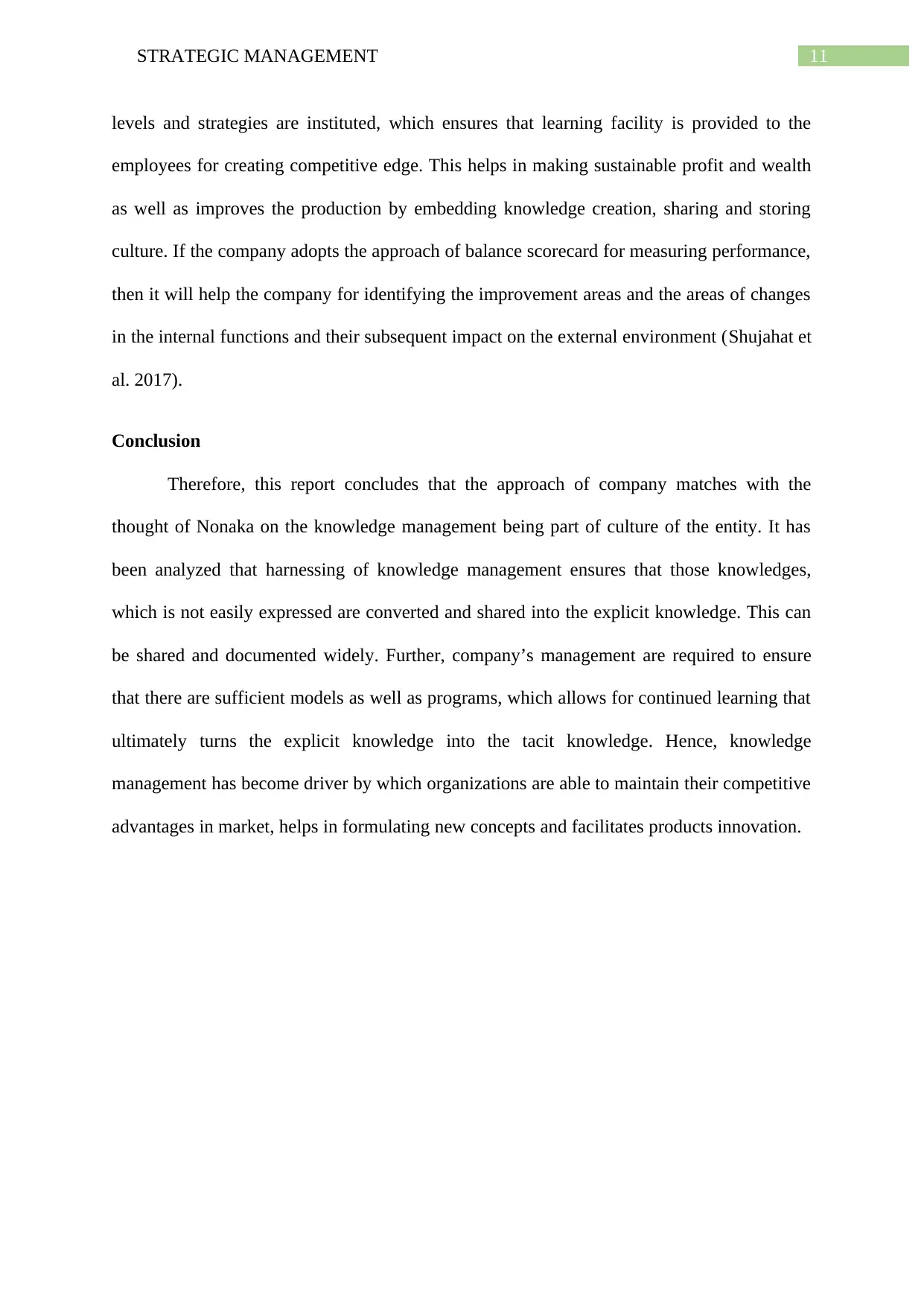
11STRATEGIC MANAGEMENT
levels and strategies are instituted, which ensures that learning facility is provided to the
employees for creating competitive edge. This helps in making sustainable profit and wealth
as well as improves the production by embedding knowledge creation, sharing and storing
culture. If the company adopts the approach of balance scorecard for measuring performance,
then it will help the company for identifying the improvement areas and the areas of changes
in the internal functions and their subsequent impact on the external environment (Shujahat et
al. 2017).
Conclusion
Therefore, this report concludes that the approach of company matches with the
thought of Nonaka on the knowledge management being part of culture of the entity. It has
been analyzed that harnessing of knowledge management ensures that those knowledges,
which is not easily expressed are converted and shared into the explicit knowledge. This can
be shared and documented widely. Further, company’s management are required to ensure
that there are sufficient models as well as programs, which allows for continued learning that
ultimately turns the explicit knowledge into the tacit knowledge. Hence, knowledge
management has become driver by which organizations are able to maintain their competitive
advantages in market, helps in formulating new concepts and facilitates products innovation.
levels and strategies are instituted, which ensures that learning facility is provided to the
employees for creating competitive edge. This helps in making sustainable profit and wealth
as well as improves the production by embedding knowledge creation, sharing and storing
culture. If the company adopts the approach of balance scorecard for measuring performance,
then it will help the company for identifying the improvement areas and the areas of changes
in the internal functions and their subsequent impact on the external environment (Shujahat et
al. 2017).
Conclusion
Therefore, this report concludes that the approach of company matches with the
thought of Nonaka on the knowledge management being part of culture of the entity. It has
been analyzed that harnessing of knowledge management ensures that those knowledges,
which is not easily expressed are converted and shared into the explicit knowledge. This can
be shared and documented widely. Further, company’s management are required to ensure
that there are sufficient models as well as programs, which allows for continued learning that
ultimately turns the explicit knowledge into the tacit knowledge. Hence, knowledge
management has become driver by which organizations are able to maintain their competitive
advantages in market, helps in formulating new concepts and facilitates products innovation.
⊘ This is a preview!⊘
Do you want full access?
Subscribe today to unlock all pages.

Trusted by 1+ million students worldwide
1 out of 14
Related Documents
Your All-in-One AI-Powered Toolkit for Academic Success.
+13062052269
info@desklib.com
Available 24*7 on WhatsApp / Email
![[object Object]](/_next/static/media/star-bottom.7253800d.svg)
Unlock your academic potential
Copyright © 2020–2025 A2Z Services. All Rights Reserved. Developed and managed by ZUCOL.




